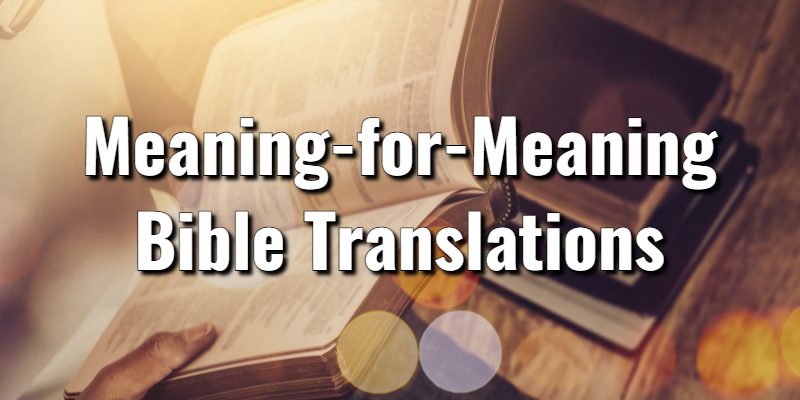Lord’s Library editors created this essential list of meaning-for-meaning Bible translations and versions to know.
Meaning-to-meaning translations focus on maintaining the overall message behind a Bible passage while attempting to achieve a higher level of readability. These Bible versions are quite popular because they flow a bit more naturally to the modern reader. But one must be careful while reading a meaning-to-meaning Bible because when translated in this way, the personally held doctrine of the translator can seep in.
Improved readability in meaning-for-meaning Bible translations is a welcomed site for those readers who become frustrated or lost when reading a word-for-word Bible. Such frustration from inaccessibility can often lead to one giving up on regular Bible study. It’s true also that translators are given a bit more freedom than those working on literal translations, which can enable them to focus on relaying the Word of God and avoid troubleshooting grammatical issues. Of course, this also invokes its own issues for some.
Meaning-for-meaning Bible translations allow for proper translation of cultural norms as well. For instance, in many places in the Old Testament, when the people of Israel sinned against God, the Bible would say, “The Lord’s nose burned against Israel.” That doesn’t make a lot of sense by itself unless you understand the cultural idioms of the times. This section tells one that God was angry with Israel. Picture someone’s face getting red when they are angry, and you will get a mental picture.
The pros of a meaning-for-meaning translation are:
- A higher level of readability can make all the difference for some new to the faith
- Translators focus on relaying God’s Word without the constraints of worrying about merging the very different vocabulary and grammatical issues when combining Hebrew, Greek, and English
- Cultural idioms can be translated in ways that make sense in our current culture
The cons of a meaning-for-meaning translation are:
- The translator’s personal beliefs can more easily seep into the Biblical text
- The Bible flows and reads much differently than its word-for-word counterpart, making some readers uncomfortable
Meaning-for-Meaning Bible Translations
Christian Standard Bible (CSB)
The Christian Standard Bible (CSB) aims to translate Scripture into clear, modern English. Developed by 100 scholars in 17 different Christian denominations, the version was created using a translation philosophy called Optimal Equivalence, which tries to balance linguistic precision to the original languages, and assures that words and thoughts capture the original context. The CSB is designed for both Pastors and laypeople alike.
New Revised Standard Version (NRSV)
The New Revised Standard Version (NRSV) was first published in 1989 by the National Council of Churches of Christ and is made up of several different Bible editions. The NRSV was translated by a 30-person committee made up of Protestants, Roman Catholics, and members of the Greek Orthodox Church, as well as a Jewish scholar. The New Revised Standard Version is widely ecumenical and available in three formats, including a standard version with or without Apocrypha, a Roman Catholic edition, and The Common Bible iteration.
Contemporary English Version (CEV)
The Contemporary English Version is a meaning-for-meaning Bible created by the American Bible Society as a “Bible for Today’s Family.” The first complete CEV Bible was published in 1995. It has a history of being one of the easiest of the different Bible versions to read. With that reputation also comes the belief that it’s a “dumb-downed” version of the Bible that glosses over much of the impact of more traditional translations.
The New American Bible (NAB)
The New American Bible was first published in 1970. It is the only translation approved for use at Mass in the Latin-rite Catholic dioceses of the United States and the Philippines. The New American Bible is also widely used by the Episcopal Church in the United States. The NAB Bible was translated by members of the Catholic Biblical Association of America (CBA). In light of this, it carries a Catholic mindset in its translation, bringing it much criticism in protestant circles.
The New International Version (NIV)
The New International Version was created to meet the need for a Bible in modern English using the earliest, highest-quality manuscripts available. The translators also aimed to create a reading of God’s Word that would be accessible to a wide audience in terms of language. The NIV Bible was translated by a team of 15 biblical scholars representing many different evangelical denominations.
The New International Version was first published complete in 1978 by Biblica, formerly known as the International Bible Society. Later revisions in 1984 and 2011 were created in light of new manuscript discoveries. It has become one of the best-selling modern translations on the market today. Modern criticisms include those who state that the NIV has significantly altered, or downright omitted, key passages that are present in the King James Version and other, older, literal translations.
Final Thoughts
Ultimately, meaning-for-meaning Bibles are for those who would benefit from a Bible that’s easier to read and who are comfortable with the skills of the translators who translated it. These Bibles can be great resources for those who struggle with reading and understanding word-for-word Bibles as well. Sometimes, having a Bible one understands simply trumps most everything else, at least at the beginning.
Most meaning-for-meaning Bibles are still regarded to be accurate, but one should always do their own research on a particular translation before choosing one for themselves.
Lord's Library participates in affiliate programs. We may make a small commission from products purchased through this resource.
- What Does the Bible Say About Achievements? With Key Scriptures - April 11, 2025
- What does the Bible Say About Abortion? With Key Scriptures - April 11, 2025
- Prosperity Gospel Meaning in the Scriptures: Is it Biblical? - April 7, 2025

















